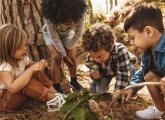When it comes to getting their children outside and learning, parents are often in need of a little encouragement, says Juno Hollyhock…
Have you ever wondered what happens when the children in your care go home – whether or not the things that they do there complement what they have done with you during the day or whether, in fact, they are very different? Young children can be immensely adaptable and will often fit into a nursery or school routine and then slot back into a home routine without too much trouble. But we might be missing an opportunity if we don’t make the time to forge some links between the two. We all know that it is essential for children to get outside during their day, that key learning and play outcomes are achievable in an outdoor environment in a way that they are not indoors. But how much do the same children get out and about with their parents and other family members. Families are under similar pressures as settings – so much to fit into the day, priorities jostling for space in an already over-packed schedule, weather issues, lack of quality space and just having the inspiration to know where to go and what to do when you get there.
So, as we are heading fast into a season rich with the potential for outdoor activities, why not think about rolling out some of the many things that you know there are to do to parents and carers as well.
All families can enjoy the outdoors together, but some may need a little encouragement to do so. By providing outdoors sessions to which families are invited, and by spending a little time with individuals to help them lead some activities, this both engages them with the setting on a less formal basis than “Little Chloe didn’t eat her chicken dippers again today” or “I need to have a quick word about David’s biting behaviour” and gives them the inspiration to turn the television off at home and get outside with their children a bit more.
Autumn is a great season for bug hunts and leaf collages, for example, and the early frosts that begin to decorate our landscapes are an ideal chance to look at some of the beautiful shapes and patterns that nature makes. The excitement surrounding bonfire night is a really good opportunity to look at safe fire-making and also to do some practical work with children, helping them to understand the importance of being careful around fireworks displays. Marshmallows and jacket potatoes love this season and relish the chance to snuggle up near a toasty flame for small mouths to enjoy. Barbecues, too, are a great way to bring families and groups of people together, and, as the nights draw in, there are some super-fun activities to be had with torches, glow-in-the-dark sticks and night-time activities such as star spotting and nocturnal mini-beast night hikes around the local park or nursery grounds.
Some families don’t know where to take their children locally without the need for expensive transport, so could your setting also provide a little local place map of fun places to visit with their children with some ideas about what to do when you get there?
No matter what you do, by reinforcing the message that ‘outdoors is good’ at home as well as at your setting, you will help children to become more engaged in nature and the world around them; their general health and fitness levels will improve, and it could be a great way to communicate even more with their families. Do any of your children have parents or carers who work in the outdoors? Is there any way that they could do a show and tell outside for the children and then have a relevant activity for the children themselves to do?
To go one step further, for those families who really have little or no access to good quality outdoor space and who don’t have the money to travel farther afield, what are the opportunities for the space around your setting to be available for community use when the nursery or school is closed? Could these spaces become their own playgrounds, enabling quality outdoor activity even in the most urban of environments? Nature and the outdoors is not just for school and nursery – are you helping your parents and carers to make the very best of what is on their doorstep?
Juno Hollyhock is executive director of Learning Through Landscapes, a UK charity dedicated to enhancing outdoor learning and play for children. For more information on a range of services and resources for early years settings, visit ltl.org.uk

Eco activities for your early years setting
Editors picks
